译林版(2020) 选择性必修第一册 Unit 1 Food Matters Reading 课件(27张)
文档属性
| 名称 | 译林版(2020) 选择性必修第一册 Unit 1 Food Matters Reading 课件(27张) | 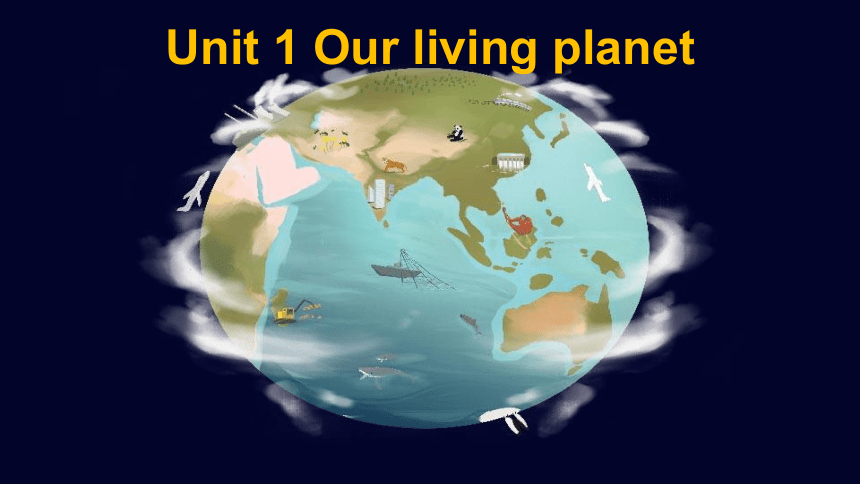 | |
| 格式 | pptx | ||
| 文件大小 | 9.7MB | ||
| 资源类型 | 教案 | ||
| 版本资源 | 牛津译林版(2019) | ||
| 科目 | 英语 | ||
| 更新时间 | 2022-09-02 17:57:16 | ||
图片预览


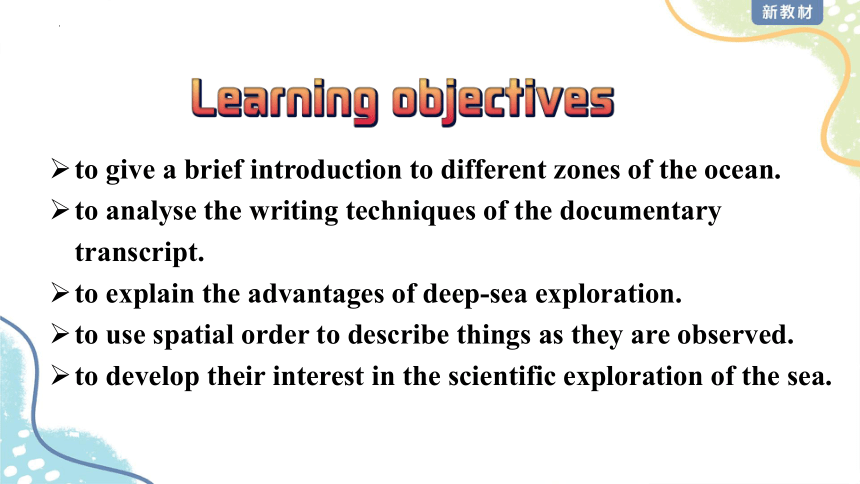
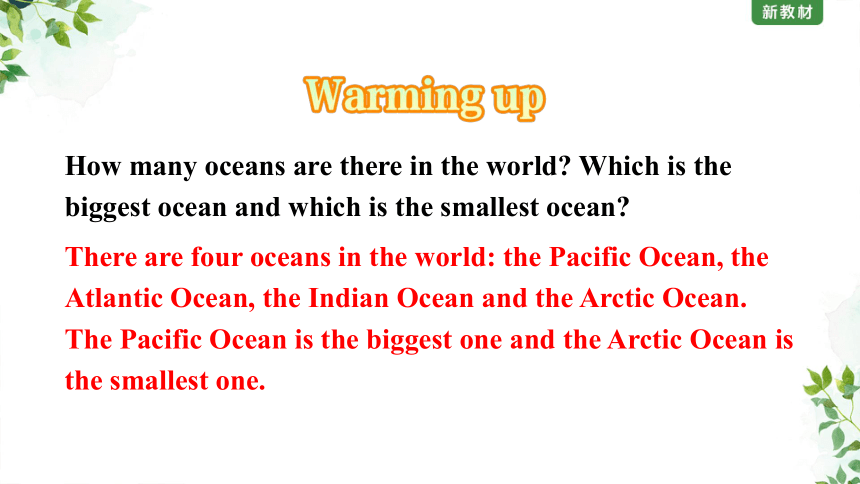
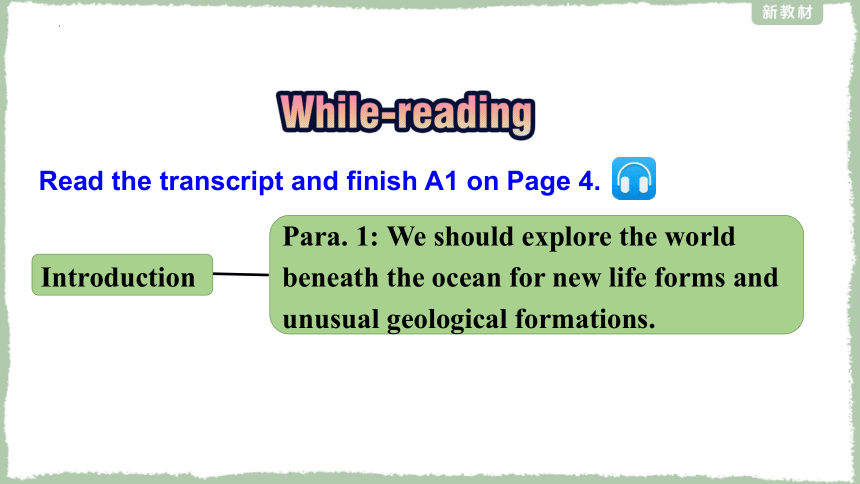
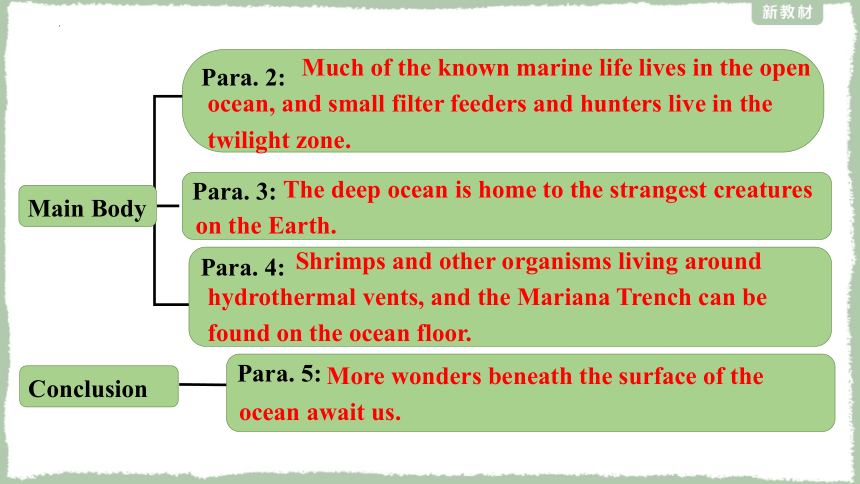
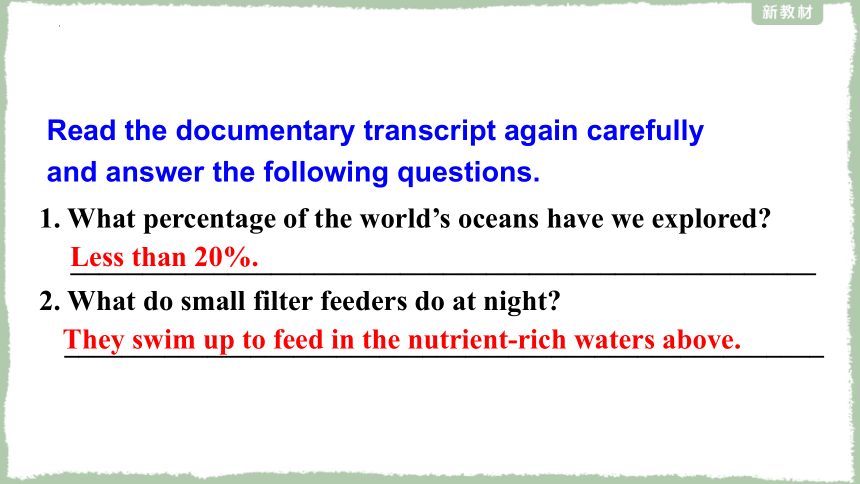
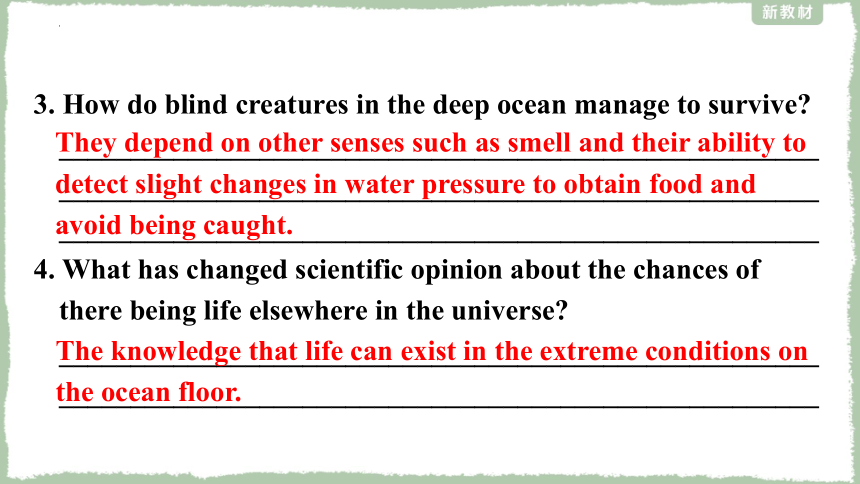
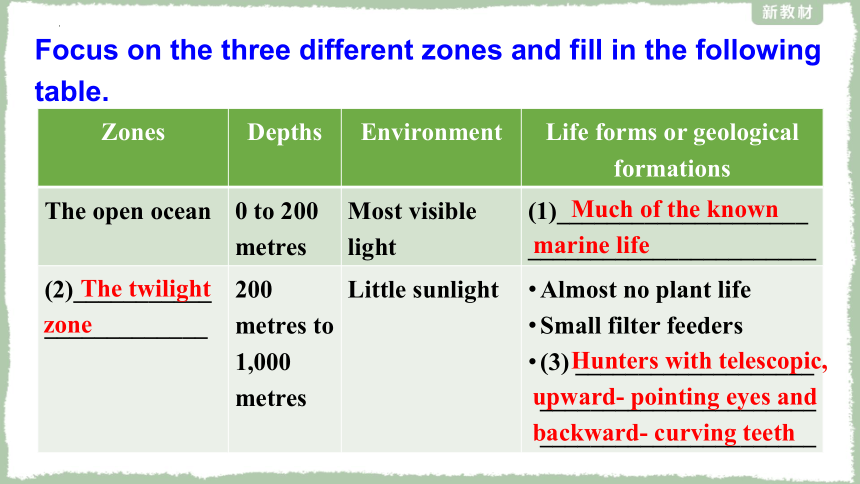
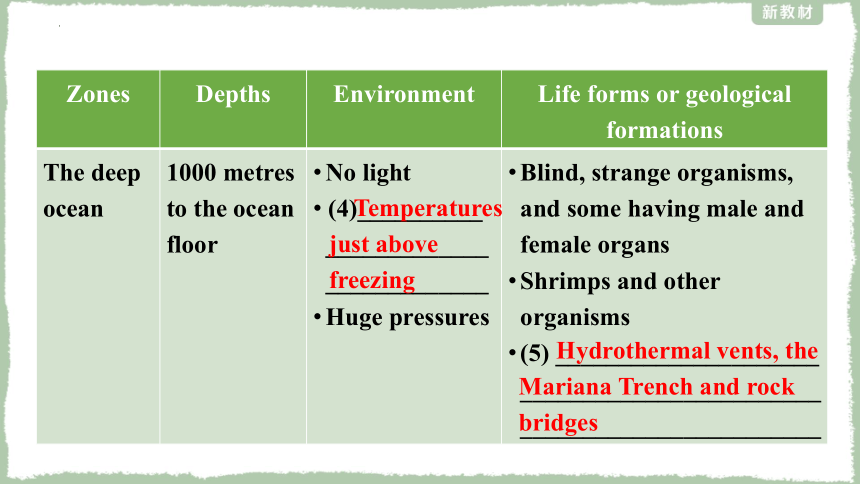
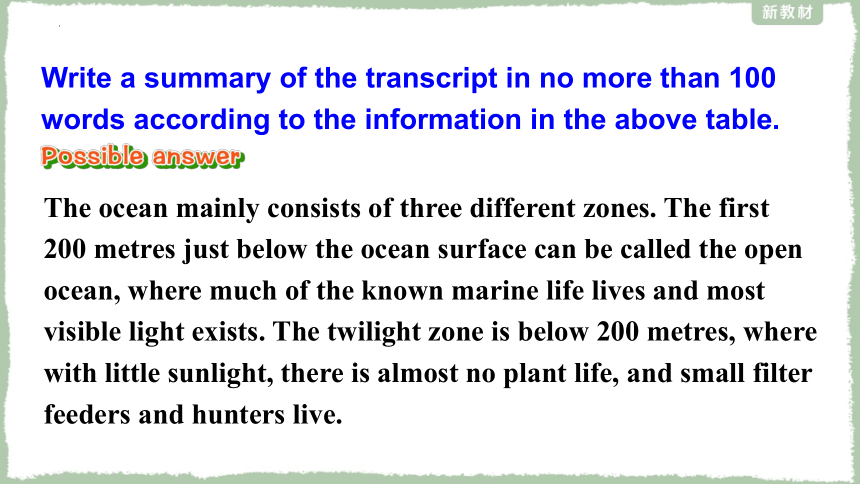
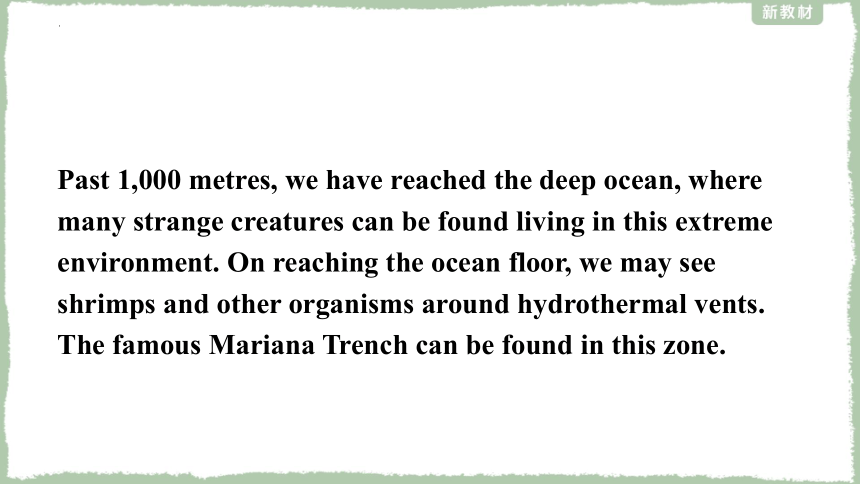
文档简介
(共37张PPT)
Unit 1 Our living planet
to give a brief introduction to different zones of the ocean.
to analyse the writing techniques of the documentary transcript.
to explain the advantages of deep-sea exploration.
to use spatial order to describe things as they are observed.
to develop their interest in the scientific exploration of the sea.
How many oceans are there in the world Which is the biggest ocean and which is the smallest ocean
There are four oceans in the world: the Pacific Ocean, the Atlantic Ocean, the Indian Ocean and the Arctic Ocean. The Pacific Ocean is the biggest one and the Arctic Ocean is the smallest one.
Introduction
Para. 1: We should explore the world beneath the ocean for new life forms and unusual geological formations.
Read the transcript and finish A1 on Page 4.
Conclusion
Main Body
Para. 4:
Para. 5:
Para. 2:
Para. 3:
Much of the known marine life lives in the open ocean, and small filter feeders and hunters live in the twilight zone.
The deep ocean is home to the strangest creatures on the Earth.
Shrimps and other organisms living around hydrothermal vents, and the Mariana Trench can be found on the ocean floor.
More wonders beneath the surface of the ocean await us.
Read the documentary transcript again carefully and answer the following questions.
1. What percentage of the world’s oceans have we explored
____________________________________________________ 2. What do small filter feeders do at night
_____________________________________________________
They swim up to feed in the nutrient-rich waters above.
Less than 20%.
3. How do blind creatures in the deep ocean manage to survive
_____________________________________________________
_____________________________________________________
_____________________________________________________
4. What has changed scientific opinion about the chances of there being life elsewhere in the universe
_____________________________________________________
_____________________________________________________
The knowledge that life can exist in the extreme conditions on the ocean floor.
They depend on other senses such as smell and their ability to detect slight changes in water pressure to obtain food and avoid being caught.
Focus on the three different zones and fill in the following table.
Zones Depths Environment Life forms or geological formations
The open ocean 0 to 200 metres Most visible light (1)___________________________________________
(2)___________ _____________ 200 metres to 1,000 metres Little sunlight Almost no plant life
Small filter feeders
(3) ___________________
____________________________________________
Much of the known marine life
The twilight zone
Hunters with telescopic, upward- pointing eyes and backward- curving teeth
Zones Depths Environment Life forms or geological formations
The deep ocean 1000 metres to the ocean floor No light (4)__________ __________________________ Huge pressures Blind, strange organisms, and some having male and female organs
Shrimps and other organisms
(5) _____________________
________________________________________________
Temperatures just above freezing
Hydrothermal vents, the Mariana Trench and rock bridges
Write a summary of the transcript in no more than 100 words according to the information in the above table.
The ocean mainly consists of three different zones. The first 200 metres just below the ocean surface can be called the open ocean, where much of the known marine life lives and most visible light exists. The twilight zone is below 200 metres, where with little sunlight, there is almost no plant life, and small filter feeders and hunters live.
Past 1,000 metres, we have reached the deep ocean, where many strange creatures can be found living in this extreme environment. On reaching the ocean floor, we may see shrimps and other organisms around hydrothermal vents. The famous Mariana Trench can be found in this zone.
Discuss the following question.
Which of the three zones (the open ocean, the twilight zone, and the deep ocean) attracts you most Why
In my opinion, the deep ocean is full of magic and mystery, which attracts me most. I thought that all life on the Earth obtained its energy from the sun. Now I know that life forms can obtain nutrients and energy from thermal sources.
Interestingly, on the ocean floor, many strange geological formations can be found, such as canyons and slopes. It is really amazing that the Challenger Deep, the deepest point of the Mariana Trench, is nearly 11,000 metres below sea level.
Read paragraph 1 and answer the following questions.
1. Why does the author mention exploring space in the introduction
Because the author wants to emphasize that the ocean should be explored and is well worth exploring just like deep space. We know more about outer space than the ocean. The ocean is full of mysteries, waiting to be solved.
2. Why are more than eighty per cent of the world’s oceans unexplored
Human beings have a passion for exploring the deepest point under the ocean. However, the conditions are extreme. The pressures are huge and there is no light. Some unusual creatures also live there. Moreover, advanced technologies need to be researched and developed to help us explore the ocean more effectively.
Read paragraph 2 and answer the following question.
How do you understand the last sentence “Evolution, it seems, helps both the hunter and the hunted in equal measure!”
The sentence emphasizes the function of evolution. It helps the hunter evolve unique characteristics, which can allow them to catch the prey more easily. However, it also helps the prey evolve survival characteristics and get away from the hunter.
Read the first and last paragraphs and answer the following question.
At the end of the first paragraph, a question is asked, and at the end of the last paragraph, another question is asked. What is the author’s purpose of writing in this way
The first paragraph aims to attract the reader to the topic of deep-sea exploration by asking the question: “Then why don’t we dive to the bottom of a really deep ocean and take a long, close look beneath the waves ”
The last paragraph serves as a conclusion. After describing the ocean deep, the author gives an ending to this documentary transcript. By asking the question: “... who knows what wonders still await us in the future ”, the author reminds the reader that the exploration of the unknown part of the ocean will never come to an end.
The documentary transcript describes the ocean in the surface- to- bottom order, which makes its content more organized and easier to follow. Find the expressions indicating the changes in position and describe Mount Qomolangma seen from the southern side in spatial order using the information below.
Major zones of Mount Qomolangma 1,000 to 2,500 metres Evergreen broadleaved forest zone
3,000 to 3,900 metres Coniferous forest zone
Above 5,500 metres Glacier zone
Learn about the writing technique of describing something in spatial order.
The first 200 metres of our dive takes us through what can be called the open ocean, …
Sinking below 200 metres, we enter the twilight zone, …
Once past 1,000 metres, we have reached the deep ocean, …
On reaching the ocean floor, we may see shrimps and other organisms…
Once we pass 1,000 metres, our first steps at the base of Mount Qomolangma take us through the evergreen broadleaved forest zone until we reach the height of 2,500 metres. Moving above to between 3,000 and 3,900 metres, we enter the coniferous forest zone, a sure sign of much colder temperatures. On reaching above 5,500 metres, we are in the glacier zone where very little vegetation can be found.
1. What’s the purpose of this documentary transcript
The purpose of this documentary transcript is to inform the reader of unusual and unexpected life forms and geological formations in the ocean.
First, this documentary transcript has a very clear structure, which includes the beginning paragraph, the body and the ending paragraph. The body deals with three different zones of the ocean. Second, spatial order is used to describe the ocean deep as it is observed, from surface to bottom.
2. What are the features of the documentary transcript
Third, the documentary transcript is narrated in the first person, from the perspective of a host, such as “Once past 1,000 metres, we have reached the deep ocean, ...”. Last but not least, some questions and exclamatory sentences are applied to arouse the reader’s curiosity about the world beneath the waves.
In pairs, discuss the following questions.
1. Why does the author mention Mount Qomolangma when describing the Challenger Deep
The author wants to highlight how deep the Challenger Deep is. By comparing it to the highest mountain in the world, Mount Qomolangma, she helps the reader visualize its depth.
2. What are the advantage of exploring the ocean
The ocean’s many unique life forms, habitats and geological formations not only help us better understand life, but also open up various opportunities for new discoveries and innovative solutions to existing problems. For instance, current discoveries of life forms in the ocean have scientists excited about the possibilities of life on planets that have extreme environments.
Further exploration could lead to new medicines, food and renewable energy sources. Besides, monitoring changes in the ocean could help scientists learn ways to address changes in the environment, such as climate change. Exploring the ocean is also a good way to find out more about how the area beneath the Earth’s crust functions. This could lead to developing better early warning systems for natural disasters like earthquakes and tsunamis.
3. If you were to write an article about the world beneath the ocean, what other information would you include
I would include some information on the plant life in the ocean, explaining what the common marine plants are, what they look like and where they can be found. I would talk about the threats facing marine creatures and how we can better preserve their habitats.
I would also include information on how humans explore the depths of the ocean as well as the challenges they face in deep-sea exploration. For instance, manned submersibles have been sent to explore the deep ocean, but challenges of deep-sea exploration include cold temperatures and high pressures.
1.Why is the ocean deep attractive to explorers
In the eyes of explorers, the ocean deep is really full of magic and mystery. Firstly, exciting new life forms can be found in there. For example, in the open ocean different marine life such as dolphins, corals and seaweeds can be found. Small filter feeders and hunters live in the twilight zone.
In the deep ocean, where the pressure can be more than 100 times the pressure of the Earth’s atmosphere, many creatures can also be found. Therefore, the variety of creatures is very rich in the ocean. Secondly, geological formations are unusual in the ocean deep. For instance, at the ocean floor exists the Mariana Trench, whose deepest point is the Challenger Deep, which is nearly 11,000 metres below sea level. In short, the world beneath the surface of the ocean is indeed an amazing place and attracts explorers greatly.
2. What are the challenges faced in deep-sea exploration
Deep- sea exploration is a highly challenging and adventurous activity and requires sophisticated equipment, large budgets, brave and experienced personnel, as well as cooperation between governments. Deep-sea divers face a number of threats like the negative physiological effects of high water pressure, threats from strange, dangerous or unknown sea creature and failure of diving equipment.
Temperatures on the ocean floor also vary greatly. It can be near freezing at a certain location while the presence of hydrothermal vents at other locations might raise the temperature to as high as 400 degrees centigrade. Visibility is often poor at great depths in the ocean and darkness prevails. Such conditions of the ocean subject both divers and submersibles to extreme stress. In the deep ocean, even a small crack in the body of a submersible can cause it to crack like a paper cup.
If you were to write about the vegetation forms of Mount Tai, what order would you use to describe them Why
I would like to use spatial order to describe the vegetation forms, either from the foot of the mountain up to the top of it or from the top of the mountain down to the foot of it. The reason is that the vegetation forms vary at different altitudes.
Extension
Finish Parts A, C and D on Pages 57–58 with your partner.
Write a passage of 100 words to describe the vegetation forms of Mount Tai.
Unit 1 Our living planet
to give a brief introduction to different zones of the ocean.
to analyse the writing techniques of the documentary transcript.
to explain the advantages of deep-sea exploration.
to use spatial order to describe things as they are observed.
to develop their interest in the scientific exploration of the sea.
How many oceans are there in the world Which is the biggest ocean and which is the smallest ocean
There are four oceans in the world: the Pacific Ocean, the Atlantic Ocean, the Indian Ocean and the Arctic Ocean. The Pacific Ocean is the biggest one and the Arctic Ocean is the smallest one.
Introduction
Para. 1: We should explore the world beneath the ocean for new life forms and unusual geological formations.
Read the transcript and finish A1 on Page 4.
Conclusion
Main Body
Para. 4:
Para. 5:
Para. 2:
Para. 3:
Much of the known marine life lives in the open ocean, and small filter feeders and hunters live in the twilight zone.
The deep ocean is home to the strangest creatures on the Earth.
Shrimps and other organisms living around hydrothermal vents, and the Mariana Trench can be found on the ocean floor.
More wonders beneath the surface of the ocean await us.
Read the documentary transcript again carefully and answer the following questions.
1. What percentage of the world’s oceans have we explored
____________________________________________________ 2. What do small filter feeders do at night
_____________________________________________________
They swim up to feed in the nutrient-rich waters above.
Less than 20%.
3. How do blind creatures in the deep ocean manage to survive
_____________________________________________________
_____________________________________________________
_____________________________________________________
4. What has changed scientific opinion about the chances of there being life elsewhere in the universe
_____________________________________________________
_____________________________________________________
The knowledge that life can exist in the extreme conditions on the ocean floor.
They depend on other senses such as smell and their ability to detect slight changes in water pressure to obtain food and avoid being caught.
Focus on the three different zones and fill in the following table.
Zones Depths Environment Life forms or geological formations
The open ocean 0 to 200 metres Most visible light (1)___________________________________________
(2)___________ _____________ 200 metres to 1,000 metres Little sunlight Almost no plant life
Small filter feeders
(3) ___________________
____________________________________________
Much of the known marine life
The twilight zone
Hunters with telescopic, upward- pointing eyes and backward- curving teeth
Zones Depths Environment Life forms or geological formations
The deep ocean 1000 metres to the ocean floor No light (4)__________ __________________________ Huge pressures Blind, strange organisms, and some having male and female organs
Shrimps and other organisms
(5) _____________________
________________________________________________
Temperatures just above freezing
Hydrothermal vents, the Mariana Trench and rock bridges
Write a summary of the transcript in no more than 100 words according to the information in the above table.
The ocean mainly consists of three different zones. The first 200 metres just below the ocean surface can be called the open ocean, where much of the known marine life lives and most visible light exists. The twilight zone is below 200 metres, where with little sunlight, there is almost no plant life, and small filter feeders and hunters live.
Past 1,000 metres, we have reached the deep ocean, where many strange creatures can be found living in this extreme environment. On reaching the ocean floor, we may see shrimps and other organisms around hydrothermal vents. The famous Mariana Trench can be found in this zone.
Discuss the following question.
Which of the three zones (the open ocean, the twilight zone, and the deep ocean) attracts you most Why
In my opinion, the deep ocean is full of magic and mystery, which attracts me most. I thought that all life on the Earth obtained its energy from the sun. Now I know that life forms can obtain nutrients and energy from thermal sources.
Interestingly, on the ocean floor, many strange geological formations can be found, such as canyons and slopes. It is really amazing that the Challenger Deep, the deepest point of the Mariana Trench, is nearly 11,000 metres below sea level.
Read paragraph 1 and answer the following questions.
1. Why does the author mention exploring space in the introduction
Because the author wants to emphasize that the ocean should be explored and is well worth exploring just like deep space. We know more about outer space than the ocean. The ocean is full of mysteries, waiting to be solved.
2. Why are more than eighty per cent of the world’s oceans unexplored
Human beings have a passion for exploring the deepest point under the ocean. However, the conditions are extreme. The pressures are huge and there is no light. Some unusual creatures also live there. Moreover, advanced technologies need to be researched and developed to help us explore the ocean more effectively.
Read paragraph 2 and answer the following question.
How do you understand the last sentence “Evolution, it seems, helps both the hunter and the hunted in equal measure!”
The sentence emphasizes the function of evolution. It helps the hunter evolve unique characteristics, which can allow them to catch the prey more easily. However, it also helps the prey evolve survival characteristics and get away from the hunter.
Read the first and last paragraphs and answer the following question.
At the end of the first paragraph, a question is asked, and at the end of the last paragraph, another question is asked. What is the author’s purpose of writing in this way
The first paragraph aims to attract the reader to the topic of deep-sea exploration by asking the question: “Then why don’t we dive to the bottom of a really deep ocean and take a long, close look beneath the waves ”
The last paragraph serves as a conclusion. After describing the ocean deep, the author gives an ending to this documentary transcript. By asking the question: “... who knows what wonders still await us in the future ”, the author reminds the reader that the exploration of the unknown part of the ocean will never come to an end.
The documentary transcript describes the ocean in the surface- to- bottom order, which makes its content more organized and easier to follow. Find the expressions indicating the changes in position and describe Mount Qomolangma seen from the southern side in spatial order using the information below.
Major zones of Mount Qomolangma 1,000 to 2,500 metres Evergreen broadleaved forest zone
3,000 to 3,900 metres Coniferous forest zone
Above 5,500 metres Glacier zone
Learn about the writing technique of describing something in spatial order.
The first 200 metres of our dive takes us through what can be called the open ocean, …
Sinking below 200 metres, we enter the twilight zone, …
Once past 1,000 metres, we have reached the deep ocean, …
On reaching the ocean floor, we may see shrimps and other organisms…
Once we pass 1,000 metres, our first steps at the base of Mount Qomolangma take us through the evergreen broadleaved forest zone until we reach the height of 2,500 metres. Moving above to between 3,000 and 3,900 metres, we enter the coniferous forest zone, a sure sign of much colder temperatures. On reaching above 5,500 metres, we are in the glacier zone where very little vegetation can be found.
1. What’s the purpose of this documentary transcript
The purpose of this documentary transcript is to inform the reader of unusual and unexpected life forms and geological formations in the ocean.
First, this documentary transcript has a very clear structure, which includes the beginning paragraph, the body and the ending paragraph. The body deals with three different zones of the ocean. Second, spatial order is used to describe the ocean deep as it is observed, from surface to bottom.
2. What are the features of the documentary transcript
Third, the documentary transcript is narrated in the first person, from the perspective of a host, such as “Once past 1,000 metres, we have reached the deep ocean, ...”. Last but not least, some questions and exclamatory sentences are applied to arouse the reader’s curiosity about the world beneath the waves.
In pairs, discuss the following questions.
1. Why does the author mention Mount Qomolangma when describing the Challenger Deep
The author wants to highlight how deep the Challenger Deep is. By comparing it to the highest mountain in the world, Mount Qomolangma, she helps the reader visualize its depth.
2. What are the advantage of exploring the ocean
The ocean’s many unique life forms, habitats and geological formations not only help us better understand life, but also open up various opportunities for new discoveries and innovative solutions to existing problems. For instance, current discoveries of life forms in the ocean have scientists excited about the possibilities of life on planets that have extreme environments.
Further exploration could lead to new medicines, food and renewable energy sources. Besides, monitoring changes in the ocean could help scientists learn ways to address changes in the environment, such as climate change. Exploring the ocean is also a good way to find out more about how the area beneath the Earth’s crust functions. This could lead to developing better early warning systems for natural disasters like earthquakes and tsunamis.
3. If you were to write an article about the world beneath the ocean, what other information would you include
I would include some information on the plant life in the ocean, explaining what the common marine plants are, what they look like and where they can be found. I would talk about the threats facing marine creatures and how we can better preserve their habitats.
I would also include information on how humans explore the depths of the ocean as well as the challenges they face in deep-sea exploration. For instance, manned submersibles have been sent to explore the deep ocean, but challenges of deep-sea exploration include cold temperatures and high pressures.
1.Why is the ocean deep attractive to explorers
In the eyes of explorers, the ocean deep is really full of magic and mystery. Firstly, exciting new life forms can be found in there. For example, in the open ocean different marine life such as dolphins, corals and seaweeds can be found. Small filter feeders and hunters live in the twilight zone.
In the deep ocean, where the pressure can be more than 100 times the pressure of the Earth’s atmosphere, many creatures can also be found. Therefore, the variety of creatures is very rich in the ocean. Secondly, geological formations are unusual in the ocean deep. For instance, at the ocean floor exists the Mariana Trench, whose deepest point is the Challenger Deep, which is nearly 11,000 metres below sea level. In short, the world beneath the surface of the ocean is indeed an amazing place and attracts explorers greatly.
2. What are the challenges faced in deep-sea exploration
Deep- sea exploration is a highly challenging and adventurous activity and requires sophisticated equipment, large budgets, brave and experienced personnel, as well as cooperation between governments. Deep-sea divers face a number of threats like the negative physiological effects of high water pressure, threats from strange, dangerous or unknown sea creature and failure of diving equipment.
Temperatures on the ocean floor also vary greatly. It can be near freezing at a certain location while the presence of hydrothermal vents at other locations might raise the temperature to as high as 400 degrees centigrade. Visibility is often poor at great depths in the ocean and darkness prevails. Such conditions of the ocean subject both divers and submersibles to extreme stress. In the deep ocean, even a small crack in the body of a submersible can cause it to crack like a paper cup.
If you were to write about the vegetation forms of Mount Tai, what order would you use to describe them Why
I would like to use spatial order to describe the vegetation forms, either from the foot of the mountain up to the top of it or from the top of the mountain down to the foot of it. The reason is that the vegetation forms vary at different altitudes.
Extension
Finish Parts A, C and D on Pages 57–58 with your partner.
Write a passage of 100 words to describe the vegetation forms of Mount Tai.
同课章节目录
- Unit 1 Food matters
- Welcome to the unit
- Reading
- Grammar and usage
- Integrated skills
- Extended reading
- Project
- Unit 2 The Universal Language
- Welcome to the unit
- Reading
- Grammar and usage
- Integrated skills
- Extended reading
- Project
- Unit 3 The art of painting
- Welcome to the unit
- Reading
- Grammar and usage
- Integrated skills
- Extended reading
- Project
- Unit 4 Exploring poetry
- Welcome to the unit
- Reading
- Grammar and usage
- Integrated skills
- Extended reading
- Project
